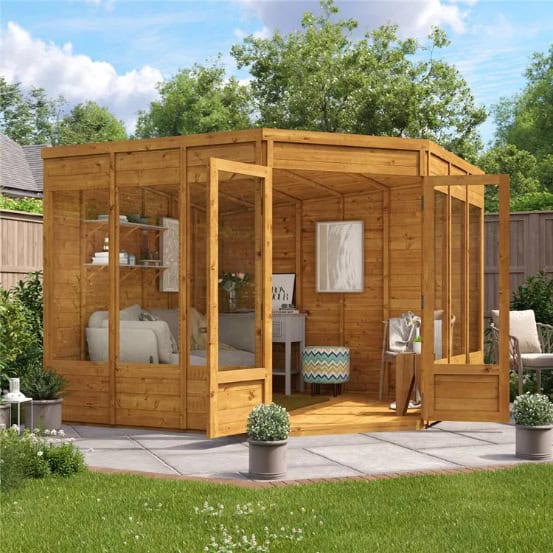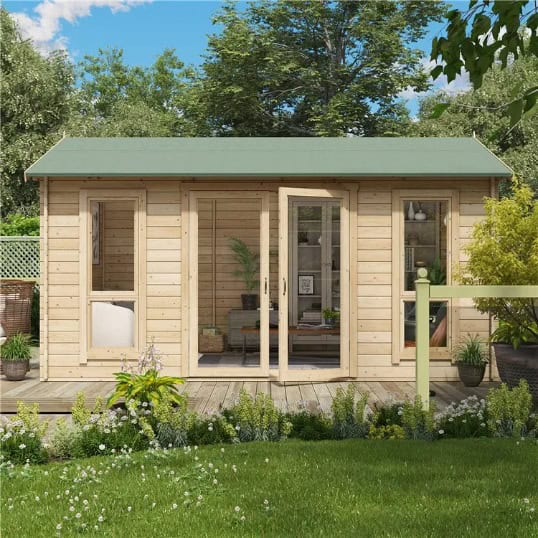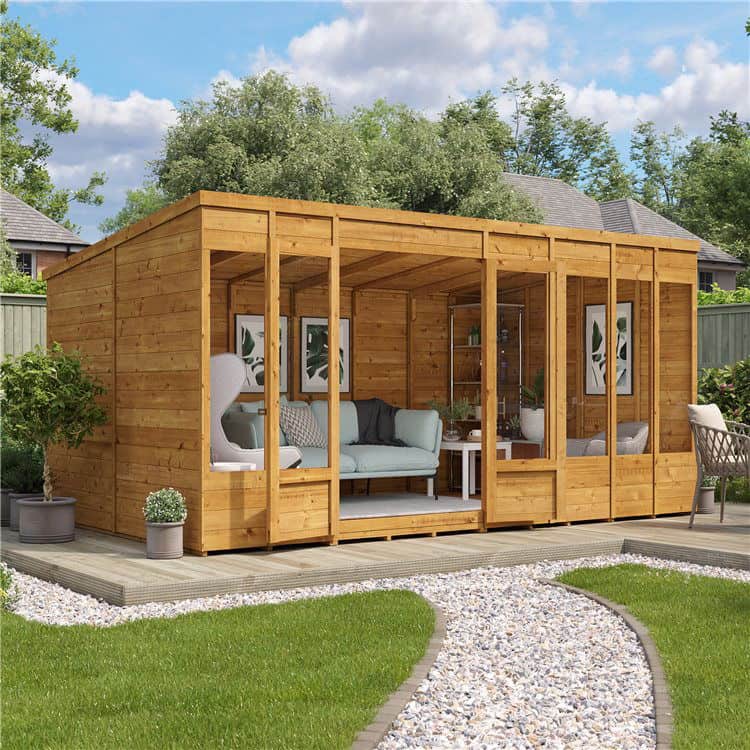Jump to:
When you’re in the market for a new summer house, you probably have a lot of questions. You might be wondering which type is best for you, how much you can expect to spend, among other queries. This guide aims to explore each type, the specific benefits of them, and help you make an informed buying decision.
What Is a Garden Summerhouse?
Garden summerhouses are standalone structures that offer a relaxing place during the warm weather. They come with windows and doors, some of which are floor-to-ceiling, so you get plenty of natural light. Some even have porch steps, verandas, or canopies to extend the space and let you enjoy the sun while lounging in your garden chair.
Benefits of a summer house
By far the best thing about a summer house is that it makes your garden pleasant to sit in even when the weather turns grey. Spring and summer rains are no longer an issue when you can simply close the doors, sit down, and enjoy the view with your family or your favourite comforts, while still maintaining an outdoor vibe.
Summerhouses are also excellent for garden privacy, as they can hide you from the view of nosy neighbours, block noise, and give you a space for private conversations.
But summerhouses aren’t just for summer, despite their name. With good insulation, they can be enjoyed year-round, even in winter. What you use them for can vary based on the type you choose. Speaking of types…
Types of Summerhouse
Summerhouses come in different styles to fit your needs. We’ll start with traditional designs and then explore contemporary options, corner styles, multi-purpose models, and those with extra features.
Traditional summerhouses

Traditional summerhouses stay true to their classic roots. They often feature an apex roof and may have wooden or shingle cladding with details like ornate shutters or carved wooden trim.
Take BillyOh Harper, for instance. It has a pitched roof for water drainage and two large glass doors at the front. The doors are divided into several small glass panes, allowing plenty of light inside. There are matching windows on each side of the doors with the same grid pattern.
A traditional summerhouse is perfect if you love a rustic, nostalgic look.
Contemporary summerhouses

Contemporary summerhouses have a fresh, updated look with minimalist designs, clean lines, and large, unobstructed windows. They can be customised with features like open-plan interiors and insulation for year-round use.
The BillyOh Dojo is a great example, offering everything a modern garden building needs! It stuns with its modern, reversible design, insulation, and double-glazing. It’s great as a garden office, gym, music room, garden pub, entertainment space, or whatever you can think of. Check it out for more information if you’re interested.
Corner summerhouses

Corner summerhouses are just as functional as standard models, but their five-sided shape sets them apart from the usual four-sided designs.
The BillyOh Picton Corner Summerhouse fits this description well. Its pentagonal design makes excellent use of corner spaces that might otherwise go to waste. For instance, with the doors placed in one corner, you don’t have to worry about extra space for them to open.
A corner summerhouse is a great option if you have limited space or a neglected nook in your garden.
Log cabin summer house

Take a cue from the BillyOh Darcy Log Cabin Summerhouse unit for reference. It has large glass windows and doors that let in plenty of light, making the space bright and relaxing, like a typical summerhouse. The roof is slightly sloped for water drainage, and the wooden deck adds extra outdoor space.
If you’re torn between a summer house and a log cabin, this could be the perfect solution.
Insulated summerhouse

As the name suggests, insulated summerhouses are designed with built-in insulation. This insulation is added to the walls, roofs, and sometimes even the floor to help regulate the temperature. The BillyOh Outpost, for one, comes fully insulated with high-performance multi-foil insulation. These layers trap heat to keep things warm in winter and cool in summer.
While adding insulation may cost more than a regular building, it saves you money in the long run, e.g., by reducing the use of electric heaters and the hassle of installing them yourself. Overall, it’s a useful feature that turns a summer house into more than just a seasonal retreat, making it a worthwhile investment.
Pressure treated summerhouse

Durability is key for wooden garden buildings as they’re exposed to the elements all year round. That’s where pressure treatment comes in — cue pressure-treated summerhouses.
These structures undergo a process where the wood is treated with preservatives under high pressure. This makes the timber material rot-resistant and protects it from decay and insect damage. Over time, this also means less maintenance. You won’t need to worry about dampness or pests damaging the wood. Plus, it saves you time and effort on future treatments or repairs.
Take a look at the BillyOh Bella Tongue and Groove Pent Summerhouse. The treatment darkens the wood and gives it a more even tone than to untreated wood. Over time, it may take on a more weathered appearance, but it will still resist rot and decay.
If you want a summerhouse that stands up to the elements and is easy to care for, pressure-treated wood is a great choice.
Please note that pressure treated wooden summerhouses should not be painted within 4-6 months of purchase due to the preserver needing to fully dry.
Summerhouse roof types
The type of roof on your garden house not only affects its aesthetic appeal within the garden, but also affects how much vertical space you have. An apex summer house (a.k.a. a peaked roof) offers a classic look that will blend with most rustic style gardens, particularly for people with a stone house or a listed building. Due to its raised height at the centre it also provides more internal space overall, in which you could hang extra lighting or decorations.
In contrast, a pent summer house (a flat roof that slopes towards the back) is a more contemporary style that will blend well with any modern garden.
Summerhouse Comparison
Here’s a table to break down some of the main decisions to think about when choosing your summer house:
| Cladding Options | Log cabin | Tongue & groove |
| Roof Options | Apex (peaked, tallest in the centre) | Pent (flat and sloped, tallest at the front) |
| Size Options | Widths: 3m to 5m | Depths: 2.5m to 4m |
| Window Styles | Front only – best for summerhouses which will go in a small space and look straight down the garden | Front and one side – best for summerhouses placed in a corner, for a multi-angled view of the garden |
Cost comparison
Budget Summerhouses (£500–£1,000)
At the low end, a cheap summerhouse is best for those with small gardens or who will benefit from seasonal use. Here’s what you can expect from this range:
Key Features to Expect:
Compact sizes (often 3m wide or less)
Single glazing or non-opening windows
Minimal insulation – best used in spring/summer
Some models will not include pressure treatment without going over £1,000
- Still a fabulous style and a 10 year guarantee
A low priced summer house will still be great for a hobby space, occasional reading nook, or a decorative garden building.
Mid-Range Summerhouses (£1,000–£2,000)
These options should suit you if you have a medium-sized garden and are looking for something slightly more functional.
Key Features to Expect:
Larger floor plans (up to 3–4m wide)
More log cabin options, which have opening windows
Upgrade options for thicker floors and roofs
- Double glazing options (with wooden frames)
Your mid-budget summerhouse would be perfect for a more activity-focused garden room, such as a garden bar or garden gym.
Premium Summerhouses (£2,000–£6,000+)
The top-of-the-range summerhouses are full-fledged garden rooms, with the most potential uses and year-round comfort. These are a much more long-term investment.
Key Features to Expect:
Generous sizes (4m+ width)
The insulated summerhouse range
uPVC double-glazed windows and doors as an upgrade option
Pressure treatment to reduce maintenance
Consider this range if you’re looking for a garden office, studio, or fully functional extension of your home.
How are Summerhouses Made?
Our BillyOh summerhouses are all manufactured in our purpose-built facility in Worksop, Nottinghamshire, UK. Each building is made to order due to the amount of customisation options available.
Our summerhouse manufacturing process includes:
- Assembly of wall panels
- Assembly of windows and doors with glazing installed into the frames
- Cutting of roof and floor boards
- Cutting of logs for log cabin summerhouses
- Pressure treating timber parts when selected
- Packaging with all nails, hinges, roof felt and other fixtures
Built from tongue and groove cladding for an attractive, watertight construction, many of our wooden summerhouses utilise pre-assembled wall panels which are simple to install. However, if your summer house is a log cabin style, it will need to be assembled from individual boards.
We would encourage you to paint and decorate your summer house to truly make it your own. Hang decorations, mount a TV, put down a rug, and enjoy your new garden experience! For decorating inspiration, check out our blog about painting a summer house.
How to Prepare your Garden for a Summerhouse
There are a few important things you have to do when you’re getting ready to install a summer house:
Build a base
All summerhouses need to be constructed on a surface that is solid, level, and doesn’t allow water to pool. Do not build a summerhouse directly on soft ground.
Our summerhouses always come with pressure treated floor bearers which prevent the floorboards from touching the ground, and can sit straight on your base surface.
There are a few different ways to go about preparing a base, whether you build one yourself or buy a base kit. The simplest option is to use your existing patio or decking, as long as it’s level (decking needs to be reinforced). If you don’t have this, the DIY methods include paving slabs or pouring concrete into a frame. The next best method that will allow you to place your summerhouse anywhere in your garden is a base kit, where all you would need to do is clear and flatten an area for it to stand.
Find out more in our Guide to Summer House Bases.
Figure out whether you need planning permission
You probably won’t need planning permission for your summerhouse, as in most cases it is counted as a ‘permitted development’ under English law.
However, there are a few boxes you need to tick in order for it to be a permitted development:
- The total space taken up by outdoor buildings and extensions must take up less than 50% of the land surrounding the original house.
- The summerhouse must be located behind the principal elevation (usually the front wall) and not forward of it.
- Your land must not have any restrictions applied to it (such as listed buildings).
- The summerhouse must not be used as a dwelling for sleeping in overnight.
There are also some height requirements, but all our summerhouses are under the maximum height limits.
Our guide to planning permission for summer houses goes into more detail so you can check whether you will need it.
Is there a best time of year to buy a summerhouse?
You can buy a summerhouse year-round, but late winter to early spring is often the best time. Prices are typically lower due to low demand, lead times are shorter, and you’ll have your building ready for use by summer. Watch for seasonal sales in autumn and winter. The only downside is you might have to install your building while it's still cold outside.
Do I need to paint my summerhouse?
Yes. Painting your summerhouse counts as treating it, which protects the timber from moisture, UV damage, and rot. Even pressure treated models benefit from a decorative topcoat or wood preservative after a number of years. Paint it soon after installation (wait 6 months if pressure treated), and plan for a recoat every year. Choose breathable, exterior-grade paints for the best result.
What’s the difference between a summerhouse and a log cabin?
The main differences are in wall thickness, insulation, and intended use. Summerhouses typically have thinner panels and are designed for seasonal leisure use. Log cabins have thicker, interlocking wall logs, offering better insulation and durability, making them suitable for use for more of the year.
Want a full breakdown? Read our guide on summerhouses vs log cabins to compare styles, features, and ideal uses.
Buy a Summerhouse
So, which summerhouse type suits your needs and garden best? Whatever that may be, this next read, ‘Summer House Ideas: Types, Designs, and Uses,’ will help you make the most of it — be sure to check it out!










